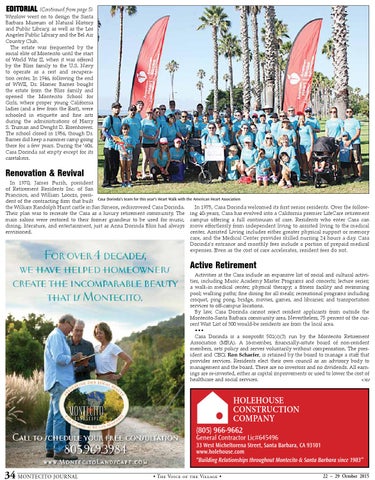EDITORIAL (Continued from page 5)
Winslow went on to design the Santa Barbara Museum of Natural History and Public Library, as well as the Los Angeles Public Library and the Bel Air Country Club. The estate was frequented by the social elite of Montecito until the start of World War II, when it was offered by the Bliss family to the U.S. Navy to operate as a rest and recuperation center. In 1946, following the end of WWII, Dr. Homer Barnes bought the estate from the Bliss family and opened the Montecito School for Girls, where proper young California ladies (and a few from the East), were schooled in etiquette and fine arts during the administrations of Harry S. Truman and Dwight D. Eisenhower. The school closed in 1956, though Dr. Barnes did keep a summer camp going there for a few years. During the ‘60s, Casa Dorinda sat empty except for its caretakers.
Renovation & Revival
In 1970, James Fursh, president of Retirement Residents Inc. of San Francisco, and William Loorzs, president of the contracting firm that built Casa Dorinda’s team for this year’s Heart Walk with the American Heart Association the William Randolph Hurst castle in San Simeon, rediscovered Casa Dorinda. In 1975, Casa Dorinda welcomed its first senior residents. Over the followTheir plan was to recreate the Casa as a luxury retirement community. The ing 40-years, Casa has evolved into a California premier LifeCare retirement main salons were restored to their former grandeur to be used for music, campus offering a full continuum of care. Residents who enter Casa can dining, literature, and entertainment, just as Anna Dorinda Bliss had always move effortlessly from independent living to assisted living to the medical envisioned. center. Assisted Living includes either greater physical support or memory care, and the Medical Center provides skilled nursing 24 hours a day. Casa Dorinda’s entrance and monthly fees include a portion of prepaid medical expenses. Even as the cost of care accelerates, resident fees do not.
Active Retirement
Activities at the Casa include an expansive list of social and cultural activities, including Music Academy Master Programs and concerts; lecture series; a walk-in medical center; physical therapy; a fitness facility and swimming pool; walking paths; fine dining for all meals; recreational programs including croquet, ping pong, bridge, movies, games, and libraries; and transportation services to off-campus locations. By law, Casa Dorinda cannot reject resident applicants from outside the Montecito-Santa Barbara community area. Nevertheless, 75 percent of the current Wait List of 300 would-be residents are from the local area. ••• Casa Dorinda is a nonprofit 501(c)(3) run by the Montecito Retirement Association (MRA). A 16-member, financially-astute board of non-resident members, sets policy and serves voluntarily without compensation. The president and CEO, Ron Schaefer, is retained by the board to manage a staff that provides services. Residents elect their own council as an advisory body to management and the board. There are no investors and no dividends. All earnings are re-invested, either as capital improvements or used to lower the cost of healthcare and social services. •MJ
HOLEHOUSE CONSTRUCTION COMPANY (805) 966-9662
General Contractor Lic#645496 33 West Micheltorena Street, Santa Barbara, CA 93101 www.holehouse.com “Building Relationships throughout Montecito & Santa Barbara since 1983”
34 MONTECITO JOURNAL
• The Voice of the Village •
22 – 29 October 2015
